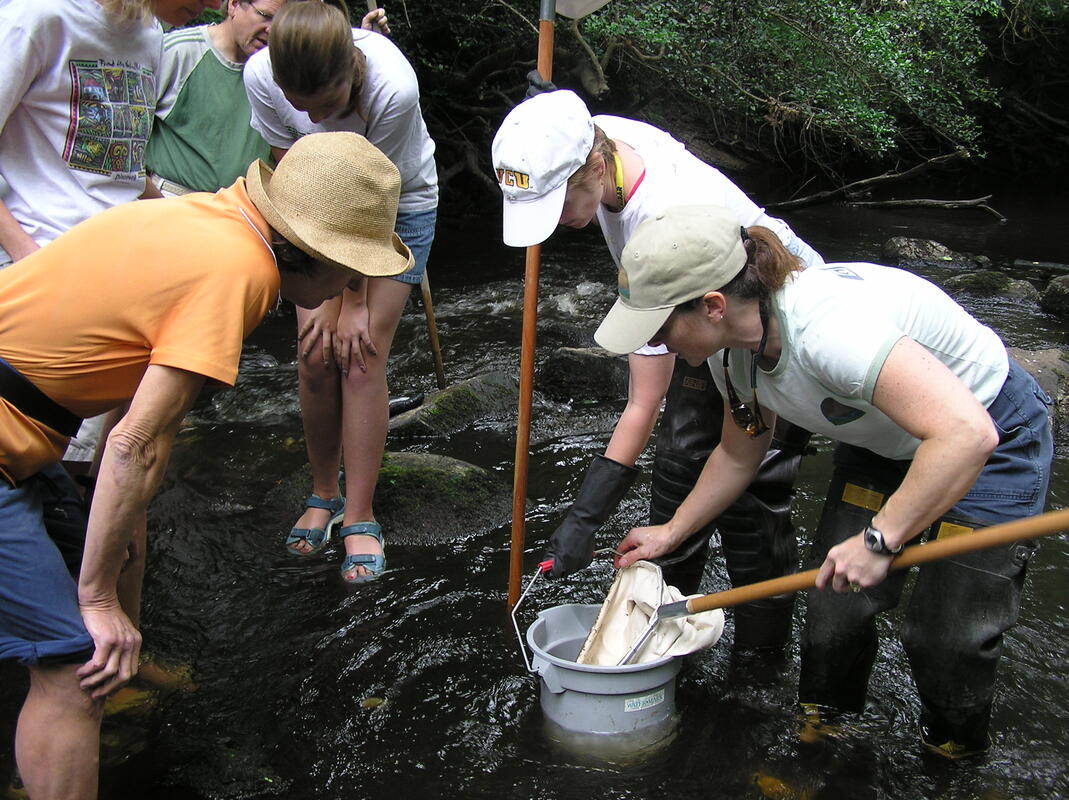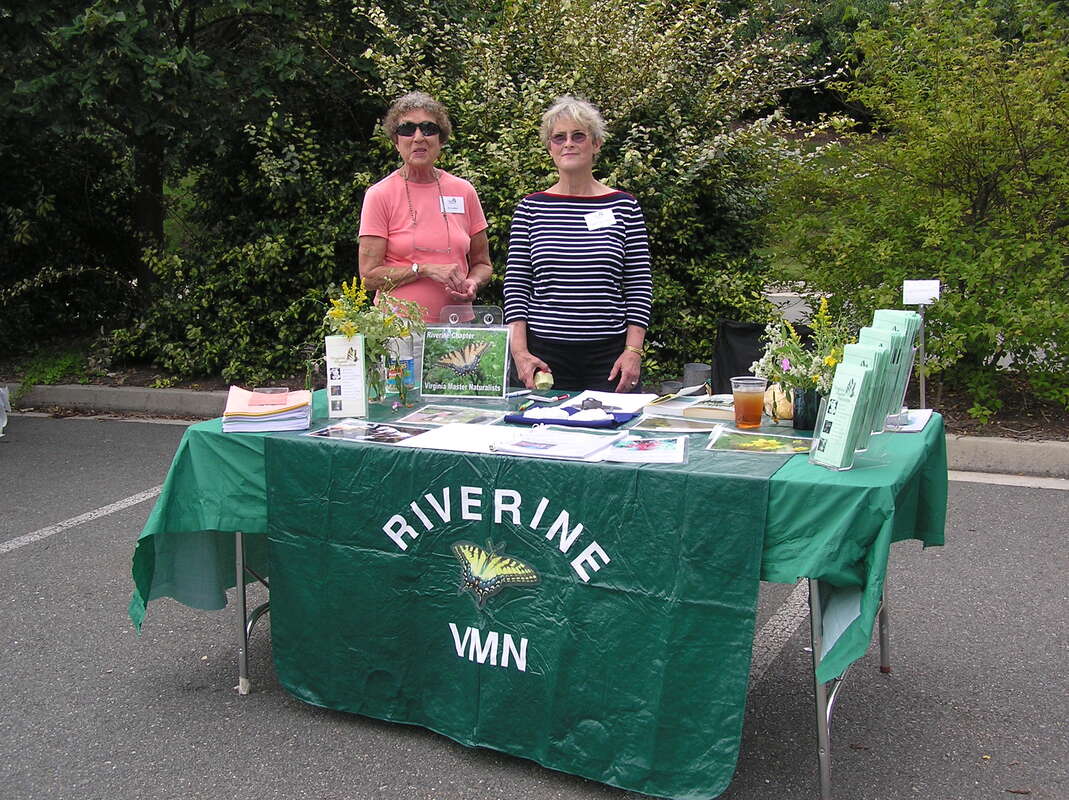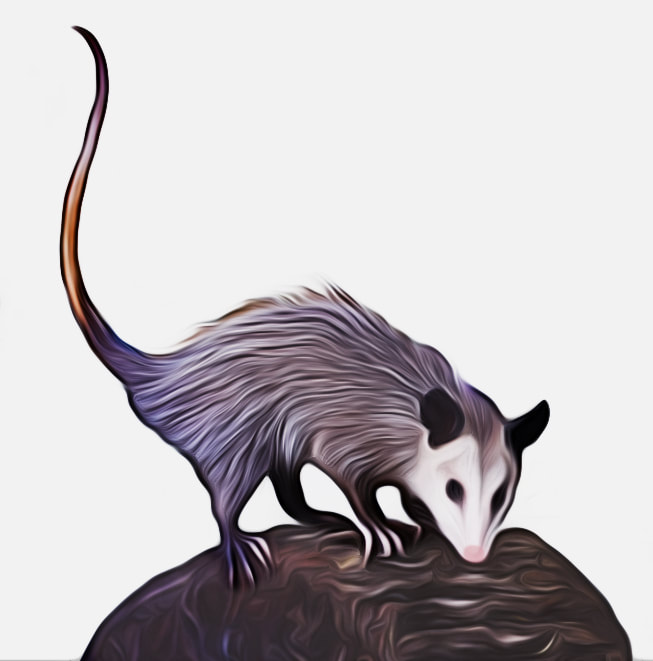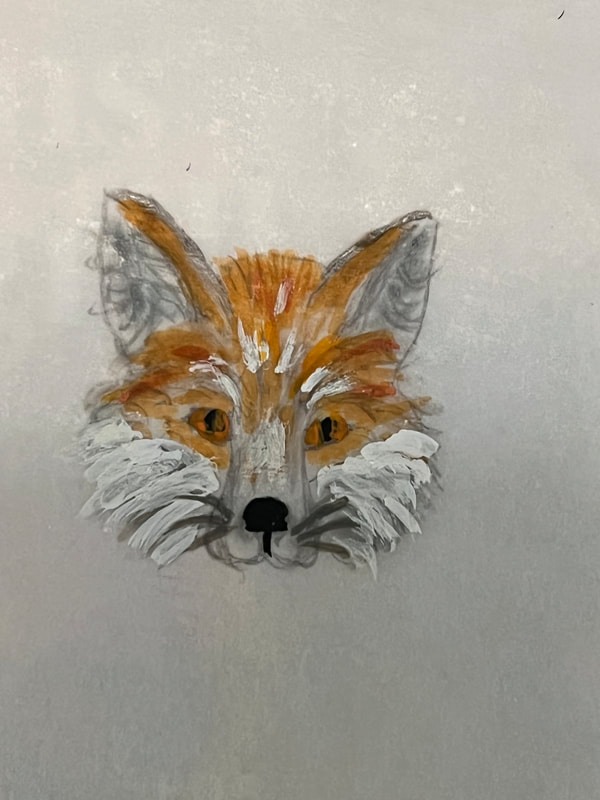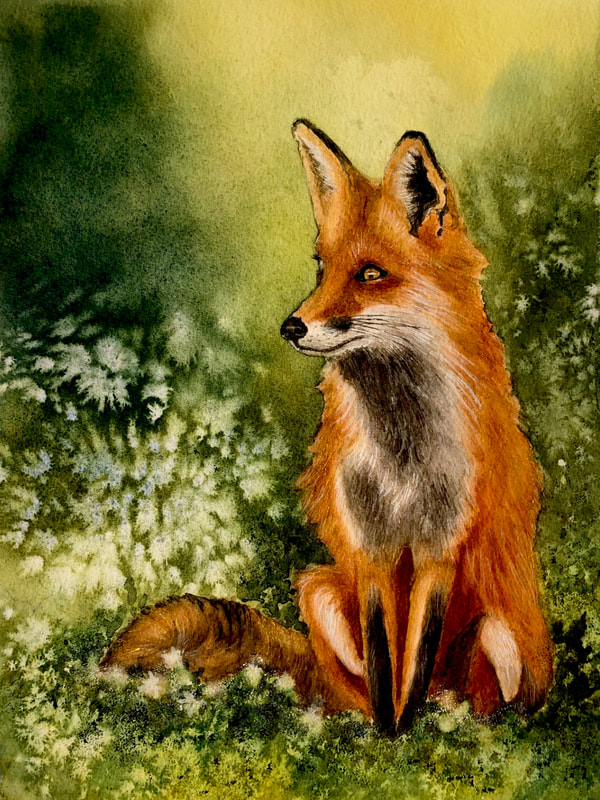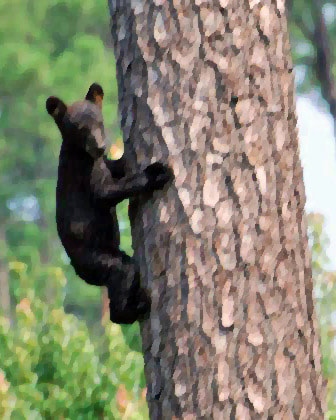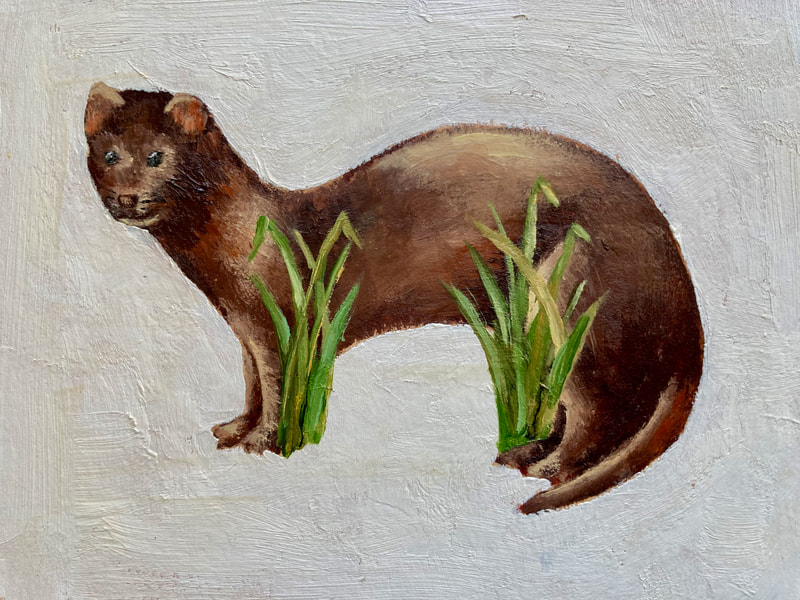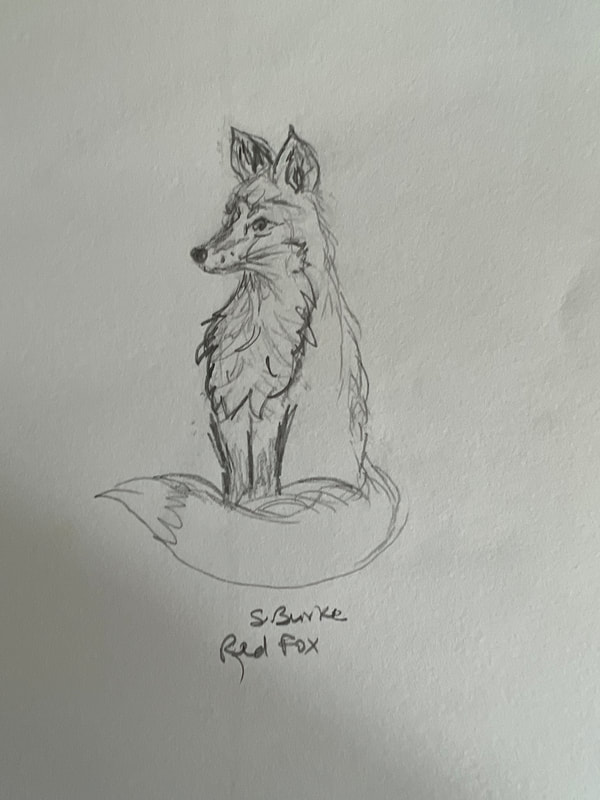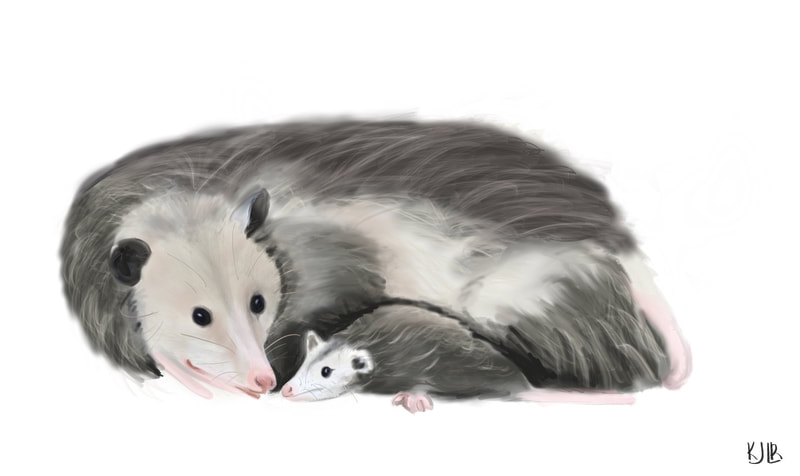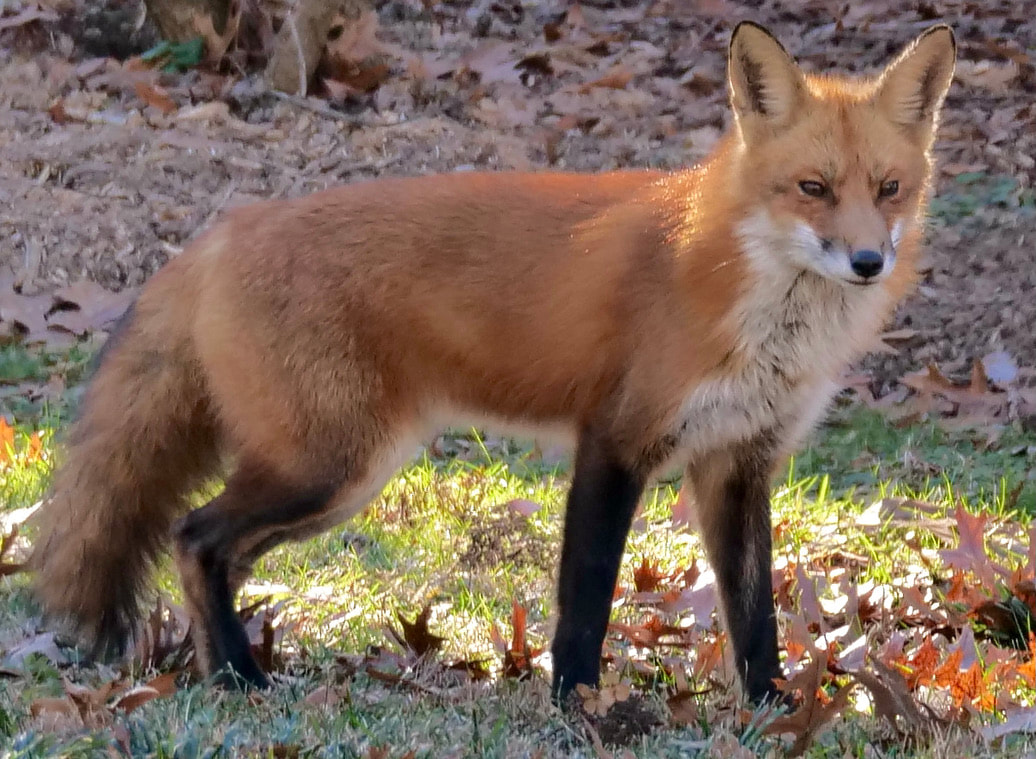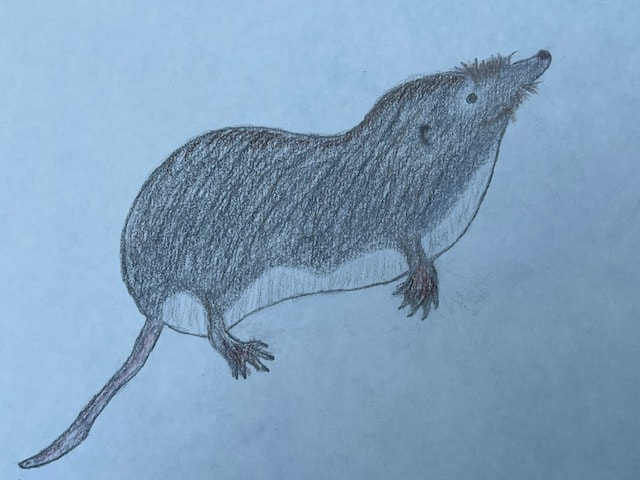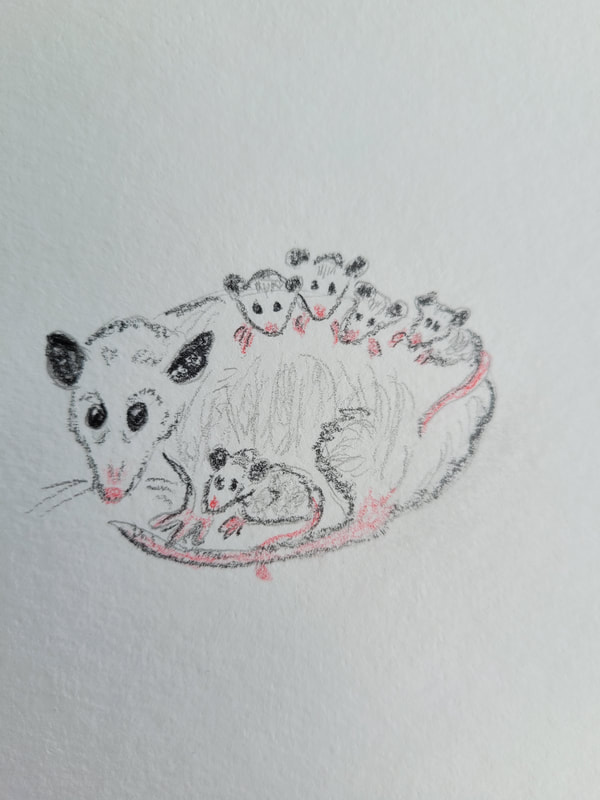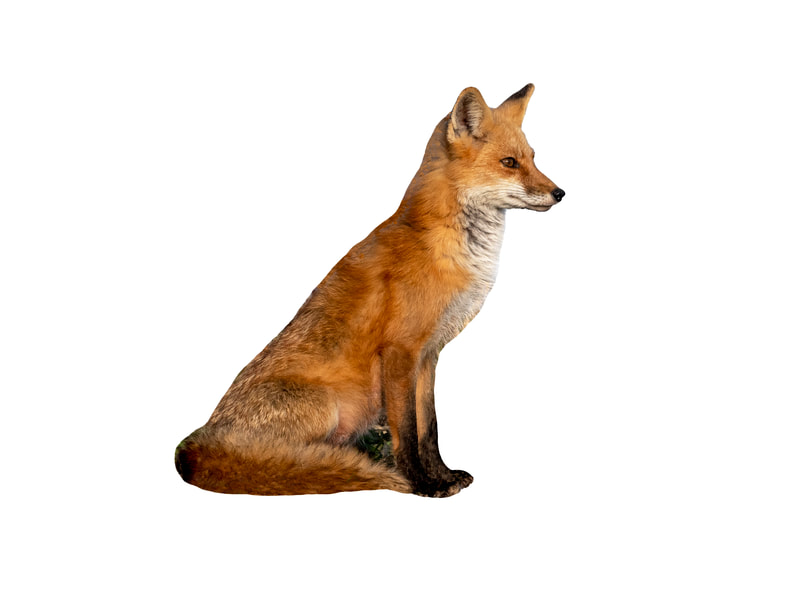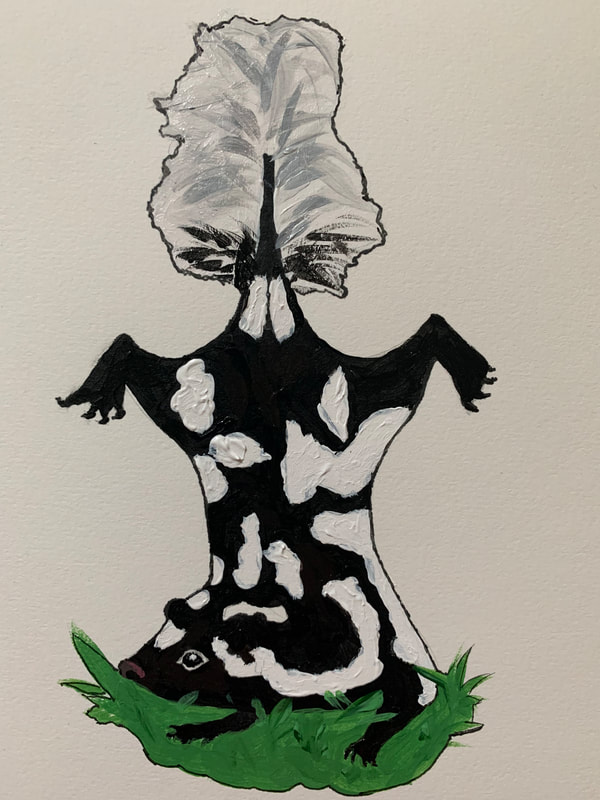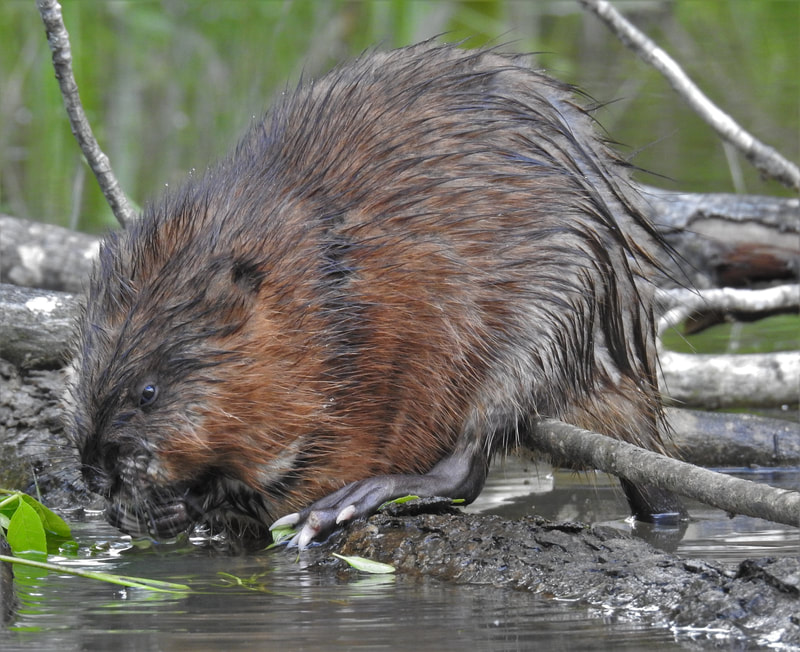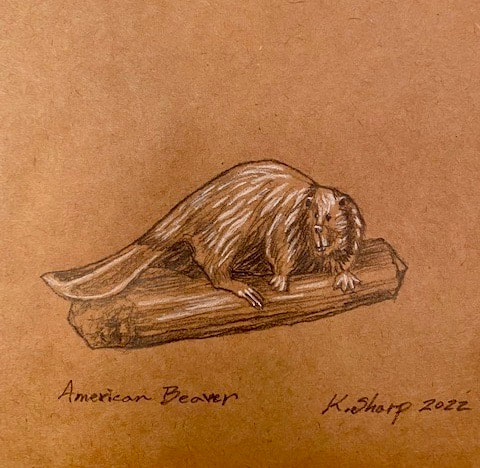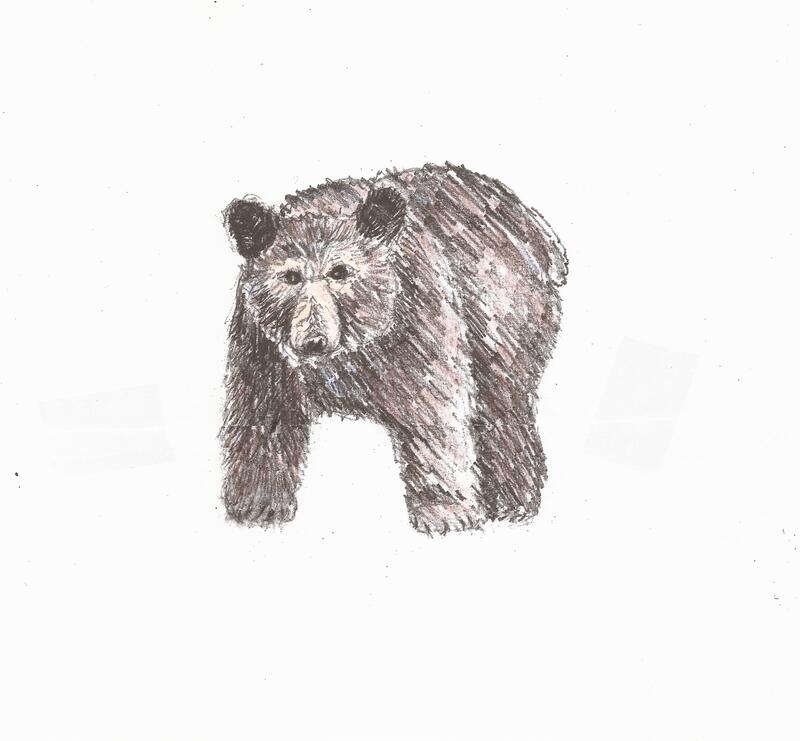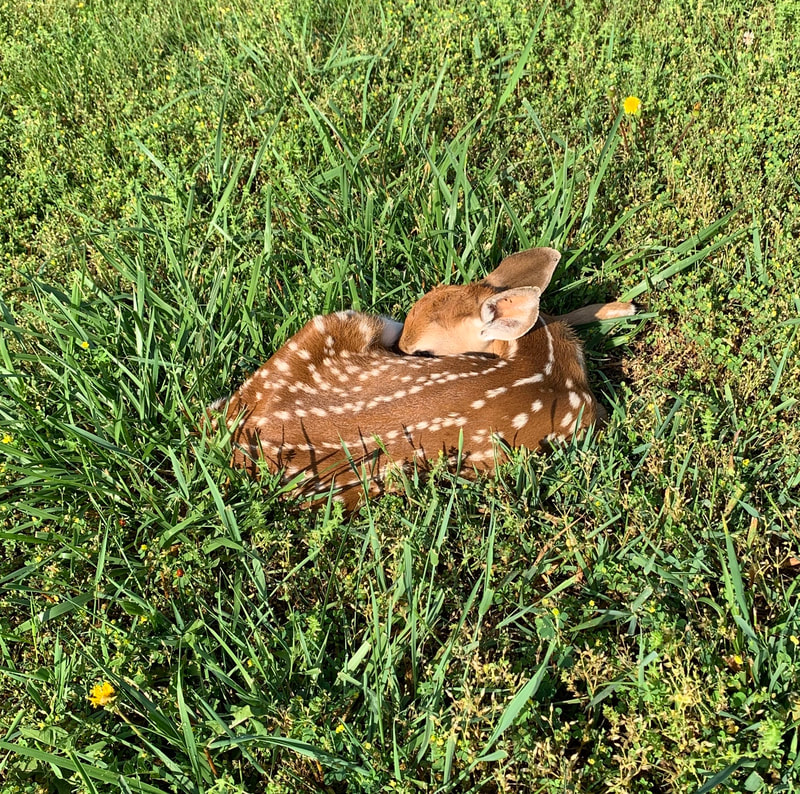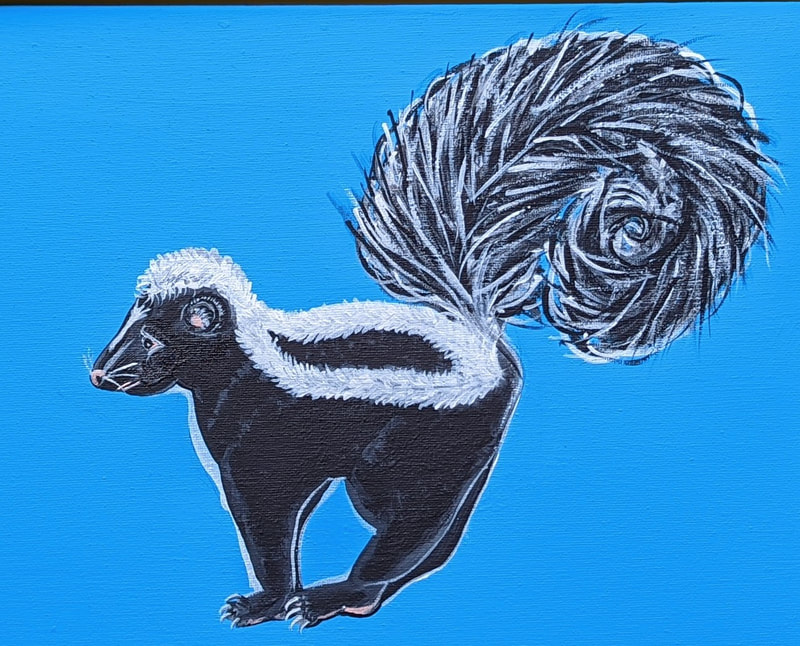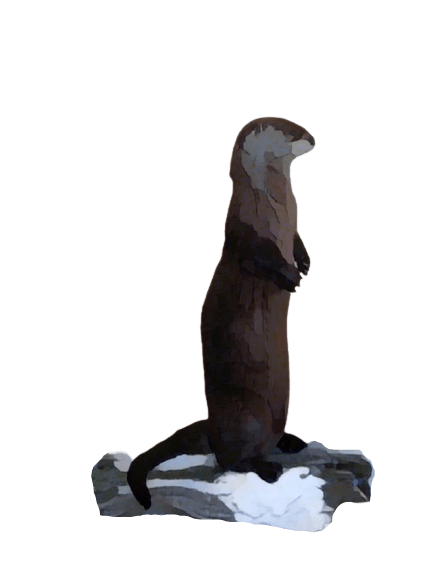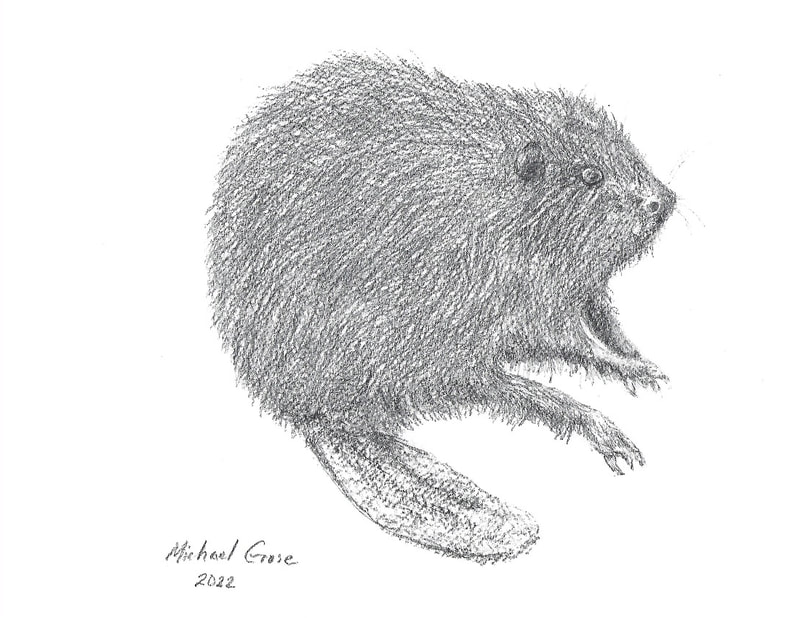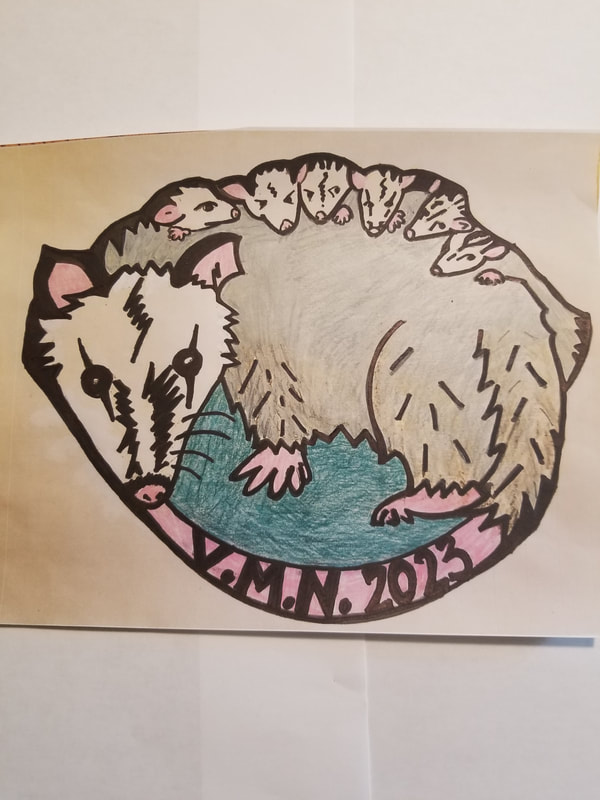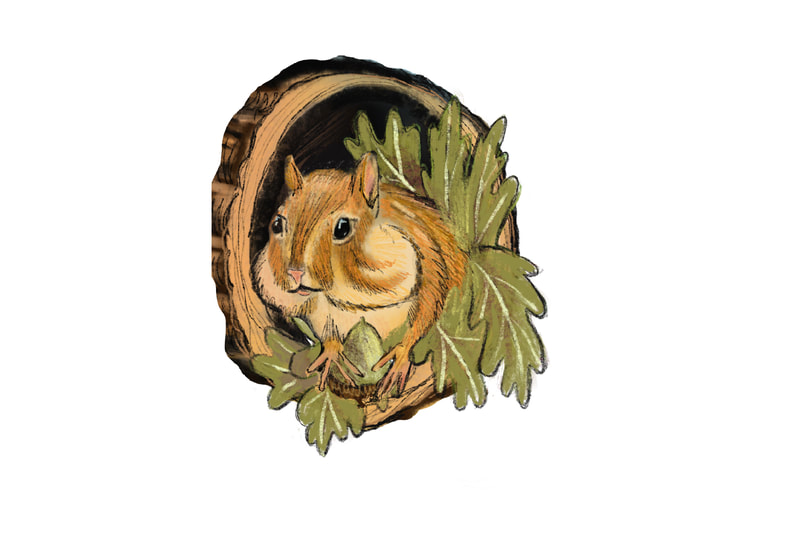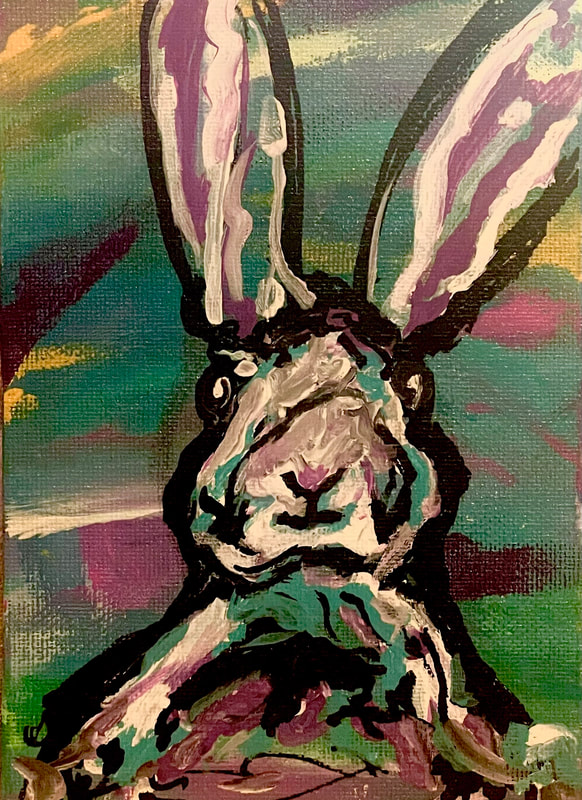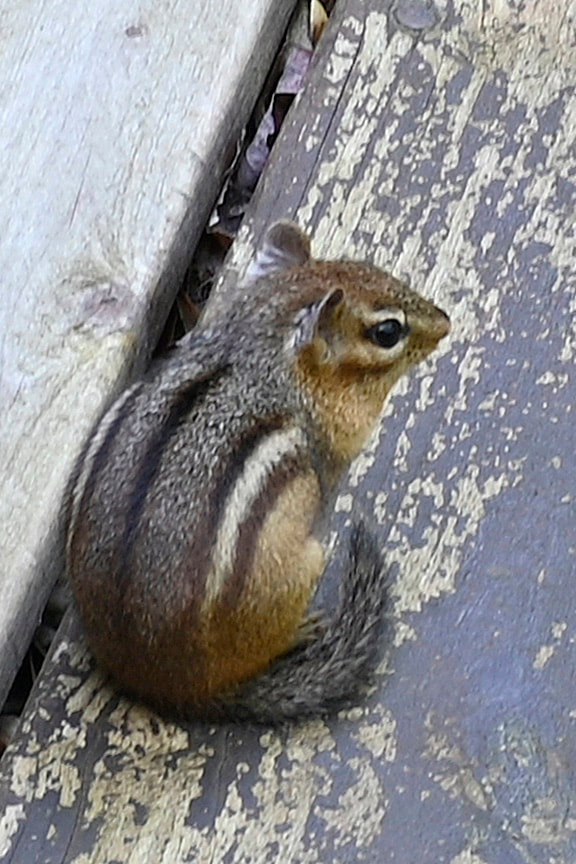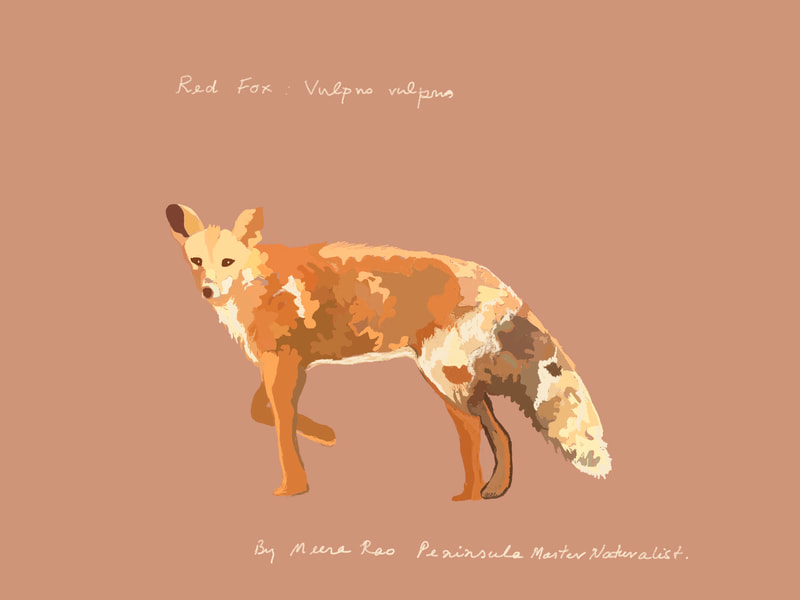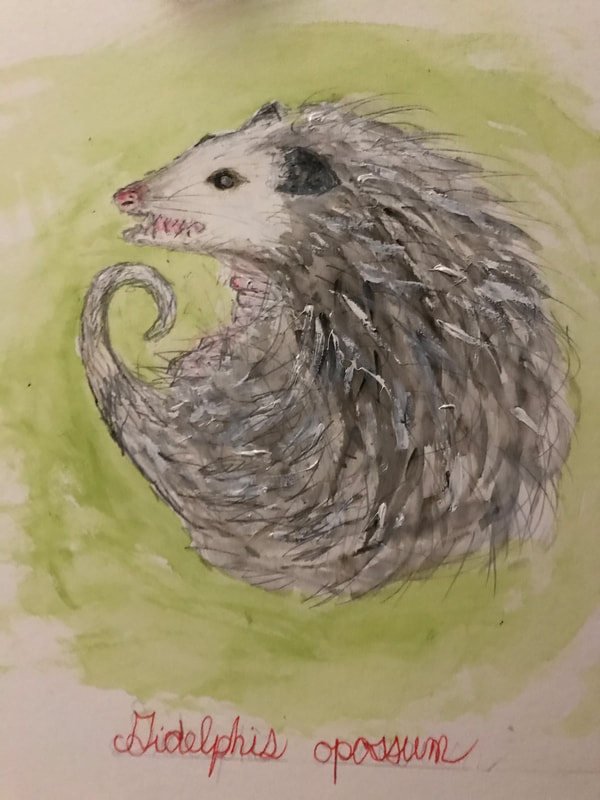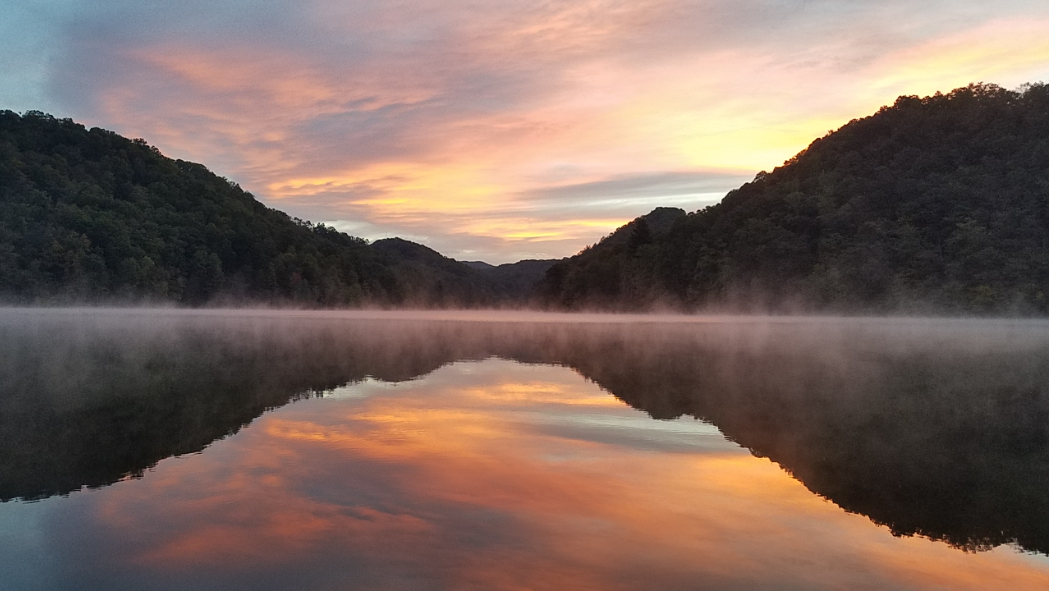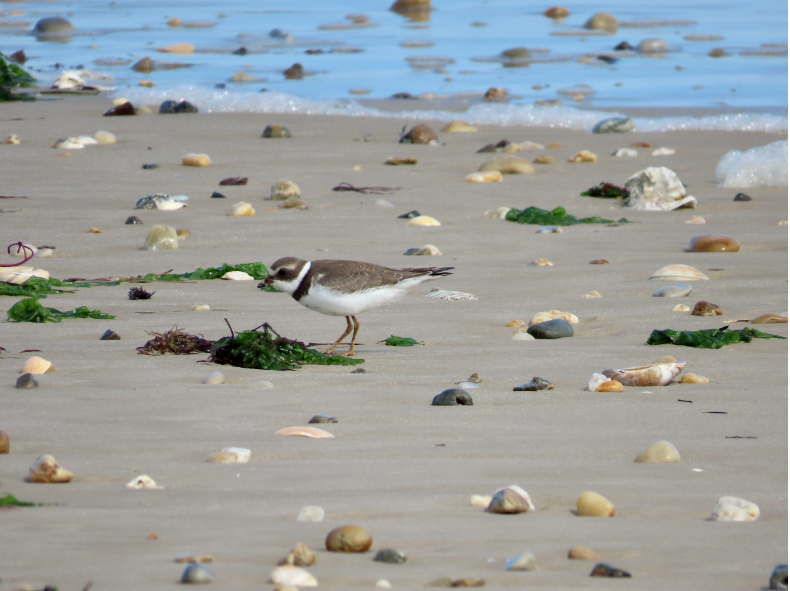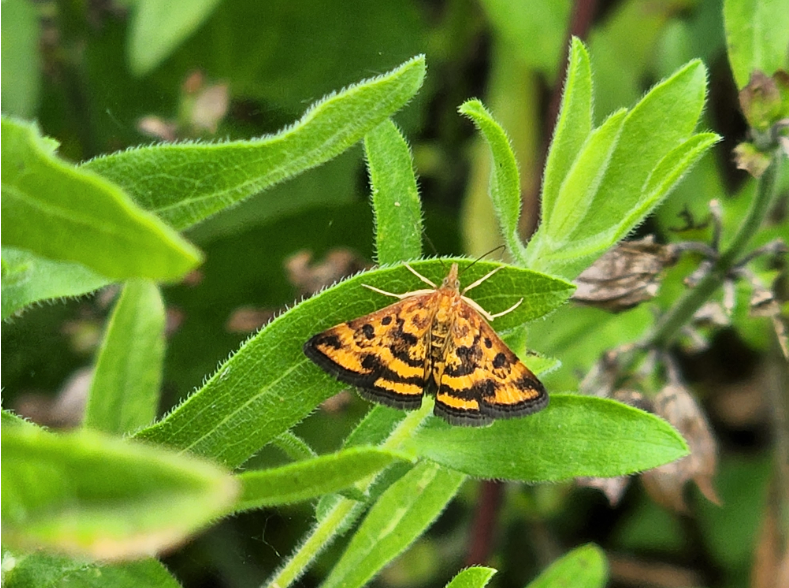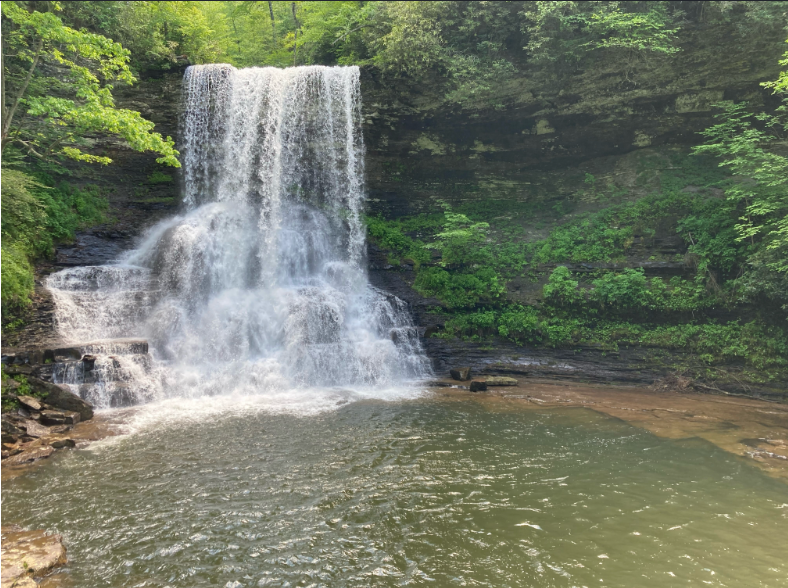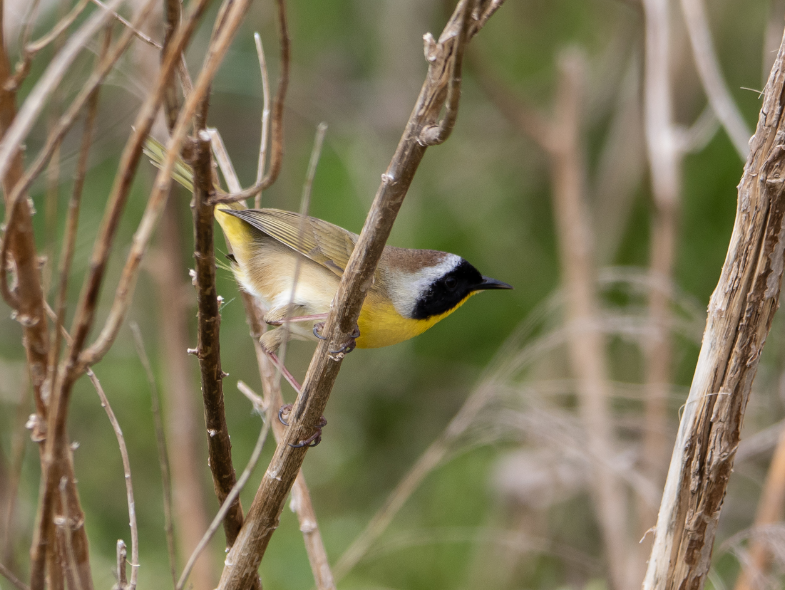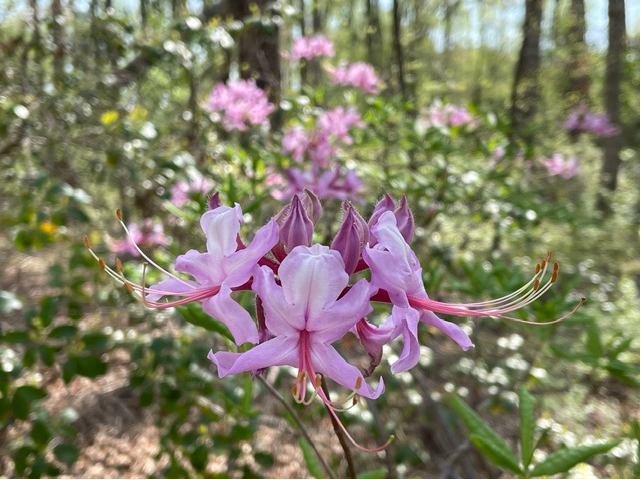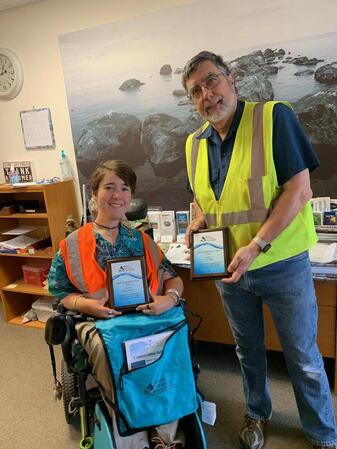 Shea Megale and Tom Ligon with their Water Quality Special Team Award from the Prince William Soil and Water Conservation District.
Shea Megale and Tom Ligon with their Water Quality Special Team Award from the Prince William Soil and Water Conservation District.
Merrimac Farm Volunteers Tom Ligon and Shea Megale Earn the Water Quality Special Team Award
–Submitted by Tom Ligon, VMN Merrimac Farm Chapter
Shea and I have a route of 22 chemical water quality monitoring sites that we test monthly. We use the Prince William Soil and Water Conservation District (PWSWCD) YSI Pro DSS probes. We monitor both county sites and a number for David Ek, the City of Manassas stormwater manager (but really an environmentalist). The PWSWCD just won national honors for the scope of their volunteer program. They started with one probe and are now up to three to handle the demand. They also have a very active benthic macroinvertebrates monitoring program, plus stewardship volunteer activities, and Merrimac Farm VMN provides many of the volunteers.
Apparently, 22 sites every month is a lot? We were both awarded the Water Quality Special Team Award from the PWSWCD, recognizing “dedication and continued commitment in keeping Prince William County beautiful!”
Shea handles data recording and is my safety backup for more difficult sites. She’s able to get close enough to some of our sites to handle the probe herself. She recently led a nature hike in Cub Run Park in which she demonstrated that she is able to ford some streams (there are several concrete-bottomed fords in Cub Run). We believe Shea is the only VMN in a motorized wheelchair, but we could use more like her.
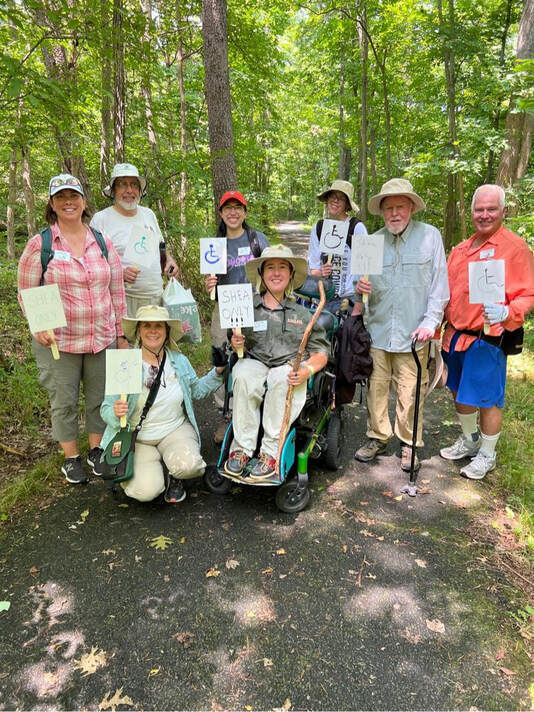
VMN volunteer Shea Megale (center) led a hike for her chapter titled “Flora, Fauna, and Feasibility: A Master Naturalist Tour on Wheels.” Photo by VMN Merrimac Farm Chapter.
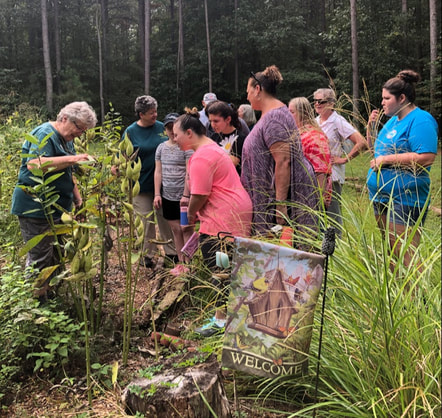 VMN volunteers in the Pocahontas Chapter led educational activities at the Bright Hope Butterfly Garden for Jacob’s Chance, a nonprofit serving people with disabilities. Photo by Kim Sasser, VMN Pocahontas Chapter.
VMN volunteers in the Pocahontas Chapter led educational activities at the Bright Hope Butterfly Garden for Jacob’s Chance, a nonprofit serving people with disabilities. Photo by Kim Sasser, VMN Pocahontas Chapter.
Pocahontas Chapter Reaches New Audiences at Bright Hope Butterfly Garden–Submitted by Lesha Berkel, VMN Pocahontas Chapter
In September, Pocahontas Chapter VMNs led a group from Jacob’s Chance for several activities at Pocahontas State Park’s Bright Hope butterfly garden. Earlier in the summer, Brooke Hsieh from Jacob’s Chance contacted Pocahontas State Park staff about coordinating a butterfly walk for several young adults with diverse abilities and their families, and Bright Hope was a perfect fit. The group toured the garden, participated in a scavenger hunt and created a butterfly art project. VMN Outreach & Education coordinator Pam Camblin organized the event for VMN volunteers who received great feedback from Jacob’s Chance staff and families for their coordination as well as their empathy in working with all who participated. Pocahontas VMNs look forward to hosting the group again in the future.
The Bright Hope butterfly garden was established seven years ago by VMN Jennifer Ambs as a citizen science project for the Monarch Larva Monitoring Project. Volunteers gather weekly from April through October to collect long-term data on larval monarch populations and milkweed habitat. The project focuses on monarch distribution and abundance during the breeding season.
Jacob’s Chance programs are open to all youth and young adults who can benefit, from 5-35 years old without regard for diagnosis, income or ability level. Programs are operated with a focus on inclusion, where volunteers (called “buddies”) without disabilities play alongside those with diverse abilities. Programs are adapted to meet the needs of each player or participant to foster understanding and accepting of diversity in physical, intellectual, and developmental abilities.
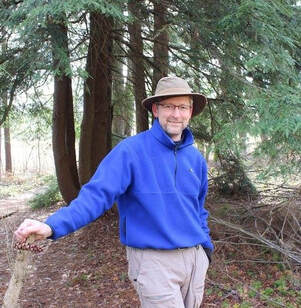 Tim Koppenhaver, VMN volunteer and Outreach Chair in the Shenandoah Chapter.
Tim Koppenhaver, VMN volunteer and Outreach Chair in the Shenandoah Chapter.
Chapter Outreach Chair Creates Award-Winning Chapter Newsletter–Submitted by Mary Beth Yarbrough, VMN Shenandoah Chapter
I’d like to recognize Tim Koppenhaver, the Outreach Chair for the Shenandoah Chapter of VMN. Since completing his basic training in 2019, Tim has expertly published our chapter’s excellent
quarterly newsletter, the Saw-Whet. The newsletter was recently awarded second prize for the Excellent-in-Craft annual award by the
Virginia Outdoor Writers Association (VOWA). The Virginia Outdoor Writers Association is a coalition of writer
s, photographers, and video/film producers who inform through various media on the out-of-doors and its enjoyment. Through this association, memb strive to improve in their craft and increase their knowledge and understanding of the outdoors.
In addition to managing the chapter’s Outreach events, Tim has set a personal goal to visit one hundred Nature Conservancy (TNC) properties by the time he’s sixty, and publishes a blog on his visits. For decades, TNC has worked globally to preserve exquisitely unique, pristine, and beautiful locations around the world. The Shenandoah Chapter is quite proud of Tim!
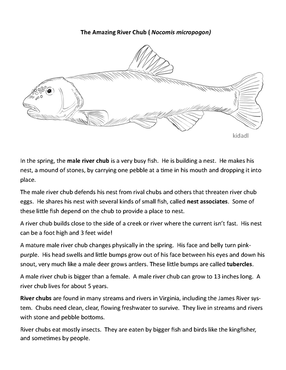 Example of one of the native fish handouts created by VMN volunteer Ellen Smyth.
Example of one of the native fish handouts created by VMN volunteer Ellen Smyth.
James River Chapter Recognizes Three Enthusiastic Volunteers
–Submitted by Maudie Miller, VMN James River Chapter
Ellen Smyth
Ellen Smyth did her Basic Training in 2019 and has had a particularly busy volunteer year in 2022. She has maintained a table at the Powhatan County Public Library to teach child patrons about native fishes of Virginia. Each month, she provides a color picture of a common VA fish with a short story of that fish and 100 coloring pages, so a child can take home a sheet
and color it in. A new fish is chosen and displayed each month. There is a prominent James River Master Naturalist placard on the table, so great outreach for us!! Ellen’s biggest project this year involved conceiving and organizing an event in collaboration with the Powhatan Library’s summer reading program for children. This was titled “Nature from the Ground Up” and involved eight tables manned by James River Chapter volunteers, including Soils, Worms, Insects, Animal Clothes, Plants, Trees, and Bird Songs (this was a short walk through the woods to an amphitheater on the library grounds, where our very talented volunteer was able to broadcast bird songs and even got some birds to respond!) We had over 70 attendees, including parents and children. Additionally, the chapter donated several youth nature books to the library. This was a huge project but Ellen’s organizational skills made it very smooth and successful.
Ellen also organized the Butterfly Count activity, in collaboration with NABA, involving 13 volunteers, including two children.
AND, her enthusiasm must be felt at home, as her husband Bill Smyth completed his James River Master Naturalists basic training in Fall of 2021. Our chapter is very lucky to have them both!!
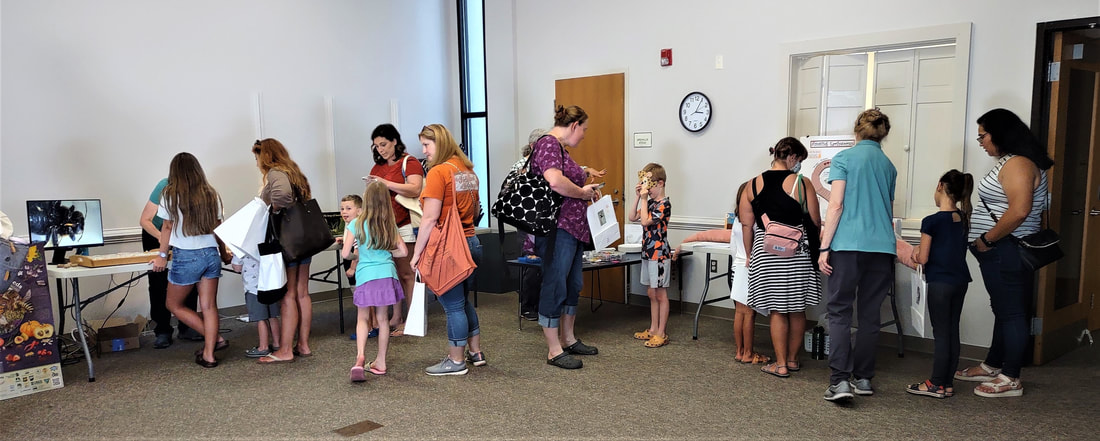
Nature From the Ground Up event at the Powhatan Library, organized by Ellen Smyth, VMN volunteer in the James River Chapter.
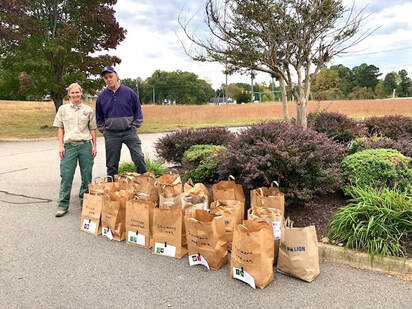 Bruce Behringer delivering acorns to the Virginia Department of Forestry. Photo by VMN James River Chapter.
Bruce Behringer delivering acorns to the Virginia Department of Forestry. Photo by VMN James River Chapter.
Bruce BehringerBruce Behringer has been a James River Chapter member since 2019. Last year he collected acorns for the VA Department of Forestry Acorn and Seed Collection Project as a solo activity.
This year he expanded this into a chapter project by setting up a Continuing Education evening at the local library. This consisted of talks by two foresters, and a YouTube video from “15 minutes in the Forest” series, on how the DOF state nursery uses our acorns to grow tree saplings. He also collected acorns from the different trees and created handouts with pictures of tree leaves of several species and their corresponding acorns, to guide our collection efforts.
On October 8, Bruce supervised volunteers at Powhatan State Park to collect acorns, and others collected in their yards and neighborhoods for a total of three counties. 175 pounds of acorns from 10 different species were delivered to the Dept of Forestry!
Bruce has also agreed to chair an AdHoc Committee on Partners, exploring ways to develop and enhance our collaborations with community partners. He has experience facilitating such collaborations in his professional role in healthcare, and we look forward to this upcoming work.
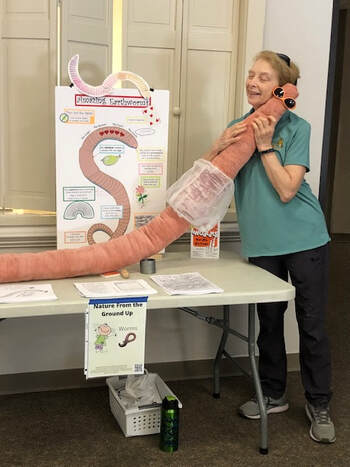 VMN volunteer Ros Reilly with her handmade earthworm friend.
VMN volunteer Ros Reilly with her handmade earthworm friend.
Ros ReillyRos Reilly, her daughter in law Sarah Reilly, and her 14year old grandson Sam Reilly were all in our training class in Fall 2021. It was really cool to have three generations in our class!! Since then, Ros has been a very active volunteer. This spring, she recruited 7 JRMN volunteers and arranged online and field training, so that they became certified as Save Our Streams monitors. This group monitors streams in Powh
atan and Goochland Counties twice a year to identify and count benthicmacroinvertebrates, a valuable measure of stream health.
In July, Ros had a fabulous table for a collaborative project with the Powhatan County Public Library as part of their summer reading program for children. Our exhibit was titled “Nature from the Ground Up” and included tables on soils, worms, insects, plants, animal clothes, trees and birdsongs. Ros’ table was a highlight and looked very professional. She sewed a 6 foot long worm , complete with a clitellum or egg sac and casts/scat. Her poster was beautifully done, and she even had a bin of worms and soil from her home vermicomposter!! The kids loved it!
Ros is currently applying for a volunteer position with the Xerces Society, doing outreach and education about invertebrate species. Her experience, knowledge and passion are well suited to this new endeavor.
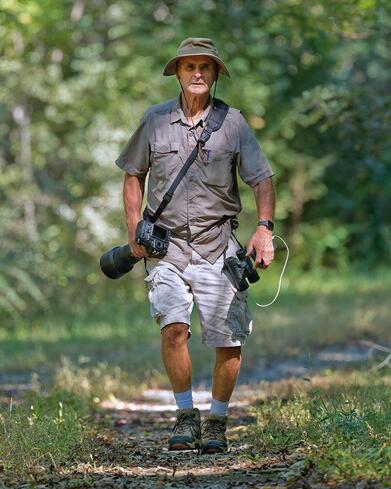 VMN volunteer Clyde Wilson, Southern Piedmont Chapter. Photo by Dan Robillard.
VMN volunteer Clyde Wilson, Southern Piedmont Chapter. Photo by Dan Robillard.
Southern Piedmont Volunteer Goes Above and Beyond for the Adopt-a-Trail Project
In August our newest chapter, the Southern Piedmont Chapter, graduated 17 VMNs from its first Basic Training course. The entire class is already doing exemplary work across the expansive, “Southside” region comprising Mecklenburg, Halifax, Brunswick, Charlotte, and Lunenburg Counties. Newly minted volunteers regularly support all three of Southside Virginia’s State Parks as well as the US Army Corps of Engineers which manages the John H. Kerr Dam and Reservoir, a 50,000-acre lake surrounded by 55,000 acres of beautiful, protected shoreline. The chapter also partnered with DWR and adopted the Christanna Loop of the Virginia Bird and Wildlife Trail (VBWT) as a group project.
Husband and wife team Clyde and Donna Wilson volunteered to lead the chapter’s participation in the VBWT Adopt-a-Trail project, and their dedication and commitment have been extraordinary. Donna works full-time and still managed to log over 75 hours supporting VBWT. Clyde went even further. Recently retired, he was able to immerse himself in the project. In addition to logging over 160 hours of eBirding, Clyde put in over 375 hours directly supporting the VBWT. Clyde personally visited all 11 spots on the Christanna Loop and met with every site owner for an initial visit. He walked all the trails on each site to assess safety, trail condition, and ensure the information on DWR’s website is up-to-date and accurate, and of course, he recorded an eBird trip at each spot. Clyde was the perfect person for the job because in addition to being a passionate birder, he’s the consummate “people person.” It had been so long since the Christanna spots were last assessed that in several cases Clyde had to do some sleuthing just to find the site owners—and then remind them that their property is part of the VBWT. He met some interesting local characters and introduced them to the VMN program as well as reminding them about their role as VBWT site owners. In one case, Clyde discovered the reason a spot had no eBird observations was because the gates were closed in the early morning (prime birding time) and an admission fee was charged upon entering the grounds. Clyde convinced the site owner to open the gates earlier and waive the admission fee for birders.
After the initial visits on the Christanna loop, Clyde and Donna introduced their fellow Basic Trainees to birding. They gave a presentation on how the VBWT project works and an introduction to the eBird app. Their goal was to support new birders and ensure that the VBWT project includes the entire chapter, including both experienced and novice birders.
Clyde emphasizes, “We’ve discovered some interesting birds as a result of making it a point to visit these seldom visited spots. Adopting the VBWT loops is important work. Without the VBWT, birders wouldn’t know these places exist, so this is important in terms of citizen science and in terms of introducing people to nature in general.”
Clyde’s passion for birds and his commitment to the VBWT is boundless. The Christanna Loop is one of 3 VBWT loops within the Southern Piedmont area that had not been inspected, assessed, or updated since at least 2007. After assessing and updating the Christanna Loop, Clyde volunteered to visit spots of the unadopted Dan River and Staunton River Loops. Although the Southern Piedmont Chapter is still too new and too small to formally adopt multiple loops, Clyde wanted to make sure they are safe and accessible. To date, he has visited all 20 stops on the Dan and Staunton River Loops and has forwarded suggestions for removing spots that are no longer open to the public and adding spots that offer excellent opportunities for wildlife viewing. Clyde hopes that as the Southern Piedmont Chapter grows, members will want to adopt an additional VBWT Loop or two.
DWR’s Meagan Thomas oversees the VBWT Adopt-a-Trail project. She says of Clyde, “Clyde’s participation in the Adopt-a-Trail project has been truly invaluable to DWR’s work to update, maintain, and promote the Virginia Bird and Wildlife Trail. His passion for birding is contagious and he has already recruited numerous volunteers to work on the project with him as well as utilized the chapter’s adopted loop to introduce the local community to the wonderful world of birding. The sheer number of hours he has contributed to the project relative to the length of time he has been participating is absolutely astounding. Not only has he demonstrated a commitment to assessing the loop that his chapter has adopted, but his work to evaluate the surrounding un-adopted loops has made him a real asset to this project. Thanks to Clyde, wildlife viewers in the Southern Piedmont have up-to-date information about the best viewing opportunities the area has to offer!”
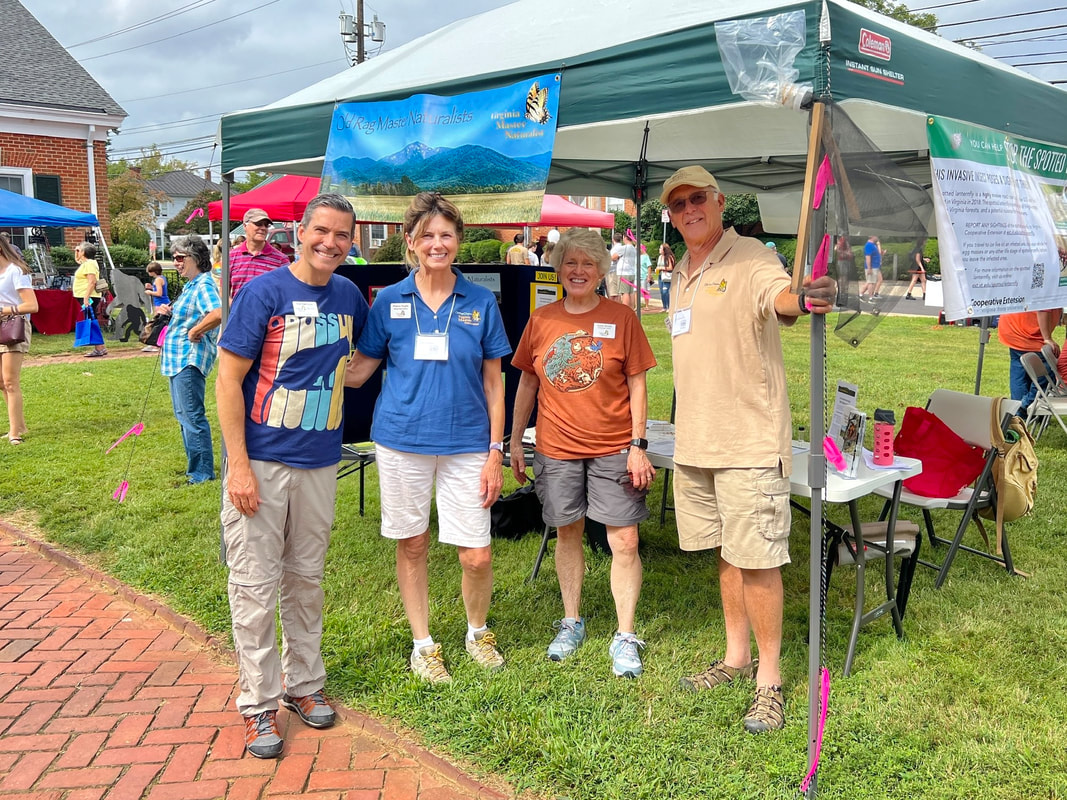
VMN Old Rag Chapter’s booth at the Madison Taste of the Mountains Festival. Photo by Karin Fangman.
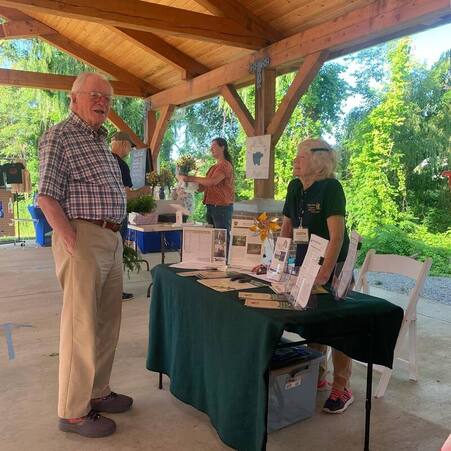 VMN volunteer Judith Stevens at the Greene County Farmers’ Market. Photo by Virginia Cooperative Extension – Greene County.
VMN volunteer Judith Stevens at the Greene County Farmers’ Market. Photo by Virginia Cooperative Extension – Greene County.
Old Rag Chapter is Back in the Saddle Again
By Charlene Uhl, VMN Old Rag Chapter
The pandemic had an impact on so much of our society’s activities. Regular events like local farmers’ markets and festivals were cancelled. Celebrations of important dates were not held or were conducted virtually. Community activities – particularly for children – didn’t happen. Now that we hopefully have turned the corner on this time of “hunkering in place”, volunteer organizations like Master Naturalist chapters are finding ways to share our message about nature and everyone can help to protect and support it.
The Old Rag Master Naturalist chapter is getting its groove back as our members are identifying community events where we can host a table, display information and talk to folks about the importance of nature, the natural world and what each person can do to support healthy habitats. Here are four events where ORMN volunteers shared this important message:
Farmers markets have always been a wonderful opportunity to get our message out. The Greene County Farmers Market is held weekly throughout the summer. Two of our members – Judith Stevens, a newly certified ORMN member and Grace Cangialosi, an experienced Master Naturalist since 2012, manned a booth every other week throughout the summer season. They worked closely with the local Extension Service, which provided information for distribution, free giveaways, and other items. Important information was posted on our display boards, which were changed regularly. There was an education focus every week (i.e., invasive plants with focus on Bradford Pear, identification and importance of local watersheds, backyard conservation efforts and weather and climate change). Sign-up sheets made sure that those who stopped by got a follow-up email encouraging them to connect to our website. A major bonus from this effort was we received applications from several Greene County residents for ORMN’s 2023 Basic Training Class.
Madison County’s Taste of the Mountains, a favorite one-day festival that draws people from all over the state, has not held for several years. So when it was announced that this major county event was going to occur this summer, ORMN member Dee Dee Lyons immediately secured a booth and recruited members to meet and greet visitors throughout the day. ORMN representatives included our President Barry Buschow; our Vice President Tom Dreier and his wife Frances, also an ORMN member; and Connie McCabe and Rob Bannister, two newly certified members. Again the opportunities to share timely information (notably the spread of the Spotted Lanternfly) as well as engage with the community were goals that were clearly achieved.
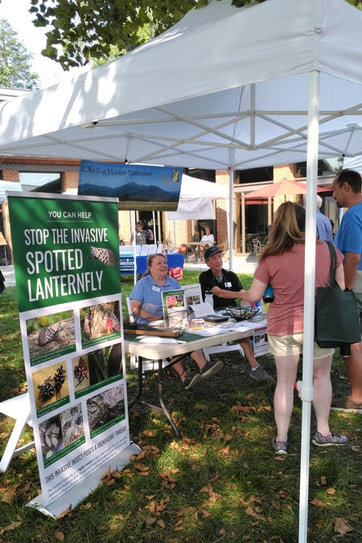 VMN volunteers in the Old Rag Chapter spread the word about stopping the invasive spotted lanternfly during Constitution Day at James Madison’s Montpelier.
VMN volunteers in the Old Rag Chapter spread the word about stopping the invasive spotted lanternfly during Constitution Day at James Madison’s Montpelier.
Montpelier’s Constitution Day celebration gave ORMN an opportunity to really focus on the threat that the Spotted Lanternfly poses to agricultural crops and Virginia’s vineyards across a broad audience from Virginia, Maryland, Washington, DC and others. Adam Downing, County Extension Agent for our area, provided banners, literature, samples of Spotted Lanternfly and other eye-catching displays that drew in 49 visitors during the 5-hour event. An enthusiastic group of four newly certified ORMN members – Cathy Crain, Beth and Dave Perrow, and Sue Weis – manned the tables and interacted with visitors.
And last and definitely not least, ORMN co-sponsored FOWL Fest. FOWL (Friends of Wildlife at the Lake) was the brain child of a group of concerned citizens at a gated community in Orange County who responded to the trapping and killing of foxes in their neighborhood. FOWL’s first year culminated with the FOWL Fest – a family-friendly festival that featured the importance and value of wildlife in Virginia. Deanne Lawrence, a FOWL member as well as a newly certified ORMN member, reached out to ORMN to help produce the event. Representatives from several Virginia agencies brought information and live animals to help educate the community about wildlife and its importance. The ORMN booth featured information on the Spotted Lanternfly (can never over-emphasize how nasty this insect is!) and was manned by Barry Buschow, Tom Dreier, Bruce Bowman, and Sue Weis along with Judith Stevens in the kids’ room. This family-friendly event was attended by community members and many others from the surrounding region. The plan is to have FOWL Fest be an annual event celebrating Virginia’s wildlife and how we each can help to support the habitats they need.
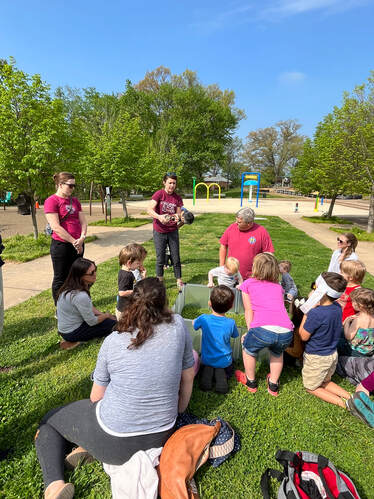 Kat Werner, VMN volunteer in the Rivanna Chapter and wildlife rehabilitator, teaching about reptiles and showing a live eastern box turtle and snake to the group at Forest Lakes Park in Charlottesville. Photo by Jill Watt.
Kat Werner, VMN volunteer in the Rivanna Chapter and wildlife rehabilitator, teaching about reptiles and showing a live eastern box turtle and snake to the group at Forest Lakes Park in Charlottesville. Photo by Jill Watt.
Rivanna Chapter Volun
teers Provide Nature Experiences for Young Children
By Carolyn Long and Jill Watt, VMN Rivanna Chapter
The Little Nature Explorers’ main purpose is to provide positive nature experiences for preschool-aged children. Jill Watt collaborated with Marjie Giuliano, another Rivanna Master Naturalist, to develop this program after attending a similar program at Ivy Creek Natural Area in Charlottesville where she discovered that her four-year-old daughter loved nature.
Jill moved to the Charlottesville area from Georgia in 2017 with her 3 children while her husband was deployed in Korea in the Army. She soon became a Charlottesville Area Tree Steward and a Rivanna Master Naturalist. Jill is currently pursuing a master’s degree in biology. When the program at Ivy Creek was paused due to the COVID pandemic in 2020, Jill and Marjie decided to start a nature program in Charlottesville for young children that would reach a more diverse population.
The Little Nature Explorers sessions are 6 weeks in length and offered through the Charlottesville Park and Recreation Department. The first session was held in the fall of 2021 with more sessions in the spring and fall of 2022. The advantages of offering the program through the city parks department include the use of various green spaces with trails, pavilions, and bathrooms in walkable neighborhoods. The program also receives free advertising through the city parks website. The free sessions usually have 12 to 14 children aged 2 to 5 plus younger siblings and at least one caregiver. A core group of volunteers designs the program each week with a leader and several helpers in attendance.
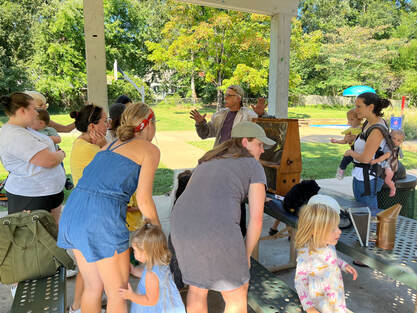 Local beekeepers present all about the importance of bees at Greenleaf Park in Charlottesville. Photo by Jill Watt.
Local beekeepers present all about the importance of bees at Greenleaf Park in Charlottesville. Photo by Jill Watt.
The Little Nature Explorers provide age-appropriate information on a different nature topic each week through storytelling, songs, activities, art projects, and hikes or walks. Some of the topics include birds, animals, trees, seeds and nuts, signs and tracks, animal habitats, and bees.
The program also promotes positive nature experiences for adult caregivers by providing information and answering their questions. Jill knows that parents have a huge impact on what their children like and dislike. When asked if there was a particular moment that was memorable, Jill described a regularly attending caregiver who was fearful of bugs and worms. Jill spoke privately to the caregiver about how important it was to not pass that fear on to the children. During a session on worms and their habitats, the caregiver held a live worm, and Jill was proud of their active participation without displaying fear.
Jill hopes that both children and caregivers leave each session with new knowledge about nature and have a positive experience that will lead them to be good earth stewards. She hopes to enlist more volunteers so that the program can expand to other parks and areas in the city. The next session will be in the spring.
Tallying Terns (and Other Birds) on the Eastern Shore
–Submitted by Brenda Poist, VMN Eastern Shore Chapter
The Eastern Shore Chapter of the Virginia Master Naturalists (ESMN) would like to recognize Paul Anderson, Martina Coker, Joanne Laskowski and Maggie Long, all ESMN who along with Coastal Virginia Wildlife Observatory (CVWO) President, Brian Taber formed team Tallying Terns as part of the Kiptopeke Challenge (KC). The Challenge is a fun and friendly team birding competition where teams compete to identify the greatest number of bird species in a single day. The primary goals of the KC are to raise funds for the CVWO and to raise awareness of fall bird migration on the Eastern Shore and along the coastal plain of Virginia. Originally scheduled for October 1, Hurricane Ian’s approach resulted in the event being postponed until October 6 when Maggie Long and Brian Taber focused their bird identification over a 10-hour period by exploring the land, creeks, ocean, and bay areas of the southern tip of Northampton County. Starting at the Eastern Shore of Virginia Wildlife Refuge at first daylight and working their way north via Sunset Beach and Kiptopeke State Park, the team then crossed the peninsula to the town of Oyster followed by the Brinkley Preserve where their bird count ended. During their birding marathon the Tallying Terns identified an impressive 106 individual bird species (list attached below). Please note that monetary donations are being accepted at the KC website until October 31. All funds raised are used to support CVWO’s field research and environmental education programs.
Birds identified by Tallying Terns, October 6, 2022:
- Canada Goose
- Wood Duck
- Green-winged Teal
- Hooded Merganser
- Brown Pelican
- Double-crested Cormorant
- Great Blue Heron
- Great Egret
- Snowy Egret
- Little Blue Heron
- Tricolored Heron
- Green Heron
- Black-crowned Night-Heron
- Yellow-crowned Night-Heron
- White Ibis
- Turkey Vulture
- Black Vulture
- Osprey
- Bald Eagle
- Northern Harrier
- Sharp-shined Hawk
- Cooper’s Hawk
- Broad-winged Hawk
- Red-tailed Hawk
- American Kestrel
- Merlin
- Peregrine
- Black-bellied Plover
- Killdeer
- American Oystercatcher
- Greater Yellowlegs
- Willet
- Spotted Sandpiper
- Marbled Godwit
- Dowitcher sp.
- Western/Semi-palmated sandpiper sp.
- Rock Pigeon
- Mourning Dove
- Laughing Gull
- Ring-billed Gull
- Herring Gull
- Great Black-backed Gull
- Royal Tern
- Forster’s Tern
- hummingbird sp.
|
- Belted Kingfisher
- Red-bellied Woodpecker
- Yellow-bellied Sapsucker
- Downy Woodpecker
- Hairy Woodpecker
- Northern Flicker
- Pileated Woodpecker
- Red-eyed Vireo
- Blue Jay
- American Crow
- Fish Crow
- Eastern Wood-Pewee
- Eastern Phoebe
- Empidonax sp.
- Tree Swallow
- Carolina Chickadee
- Tufted Titmouse
- Red-b
reasted Nuthatch
- Brown-headed Nuthatch
- Carolina Wren
- Marsh Wren
- Gray Catbird
- Northern Mockingbird
- Brown Thrasher
- European Starling
- Cedar Waxwing
- Northern Parula
- Cape May Warbler
- Black-throated Blue Warbler
- Yellow-rumped Warbler
- Pine Warbler
- Palm Warbler
- Blackpoll Warbler
- Black-and-white Warbler
- American Redstart
- Common Yellowthroat
- Scarlet Tanager
- Golden-crowned Kinglet
- Ruby-crowed Kinglet
- Blue-gray Gnatcatcher
- Veery
- Swainson’s Thrush
- American Robin
- House Sparrow
- Chipping Sparrow
|
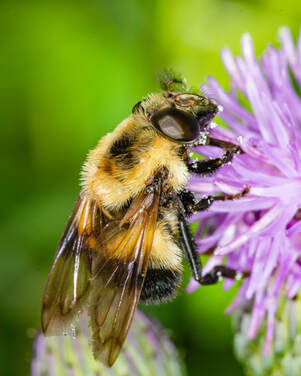 Yellow-faced Swiftwing (Volucella facialis). Photo from iNaturalist by bob15noble (CC BY-NC 2.0).
Yellow-faced Swiftwing (Volucella facialis). Photo from iNaturalist by bob15noble (CC BY-NC 2.0).
Holston Rivers Volunteer Helps Discover Flower Flies on the Blue Ridge Parkway
VMN volunteers have been participating in several biodiversity surveys on the Blue Ridge Parkway, organized by the National Park Service’s Appalachian Highlands Science Learning Center. The most recent effort has been a survey of flower flies (family Syrphidae), which are important pollinators of native plants. A significant section of the parkway remained unstudied, however, until this year, when Russ McDaniel of the Holston Rivers Chapter stepped up to the task. He visited the Fisher’s Peak Meadows and Groundhog Mountain areas of the parkway over the summer, collected flower flies (under an NPS collection permit), and delivered them to NPS scientist Paul Super for identification. Paul recently reported that Russ found twelve different flower fly species at his sites, including at least one species not previously identified for the Virginia section of the Blue Ridge Parkway.
- Oblique Stripetail (Allograpta obliqua)
- Common Drone Fly (Eristalis tenax)
- Transverse-banded Drone Fly (Eristalis transversa)
- aphideater (Eupeodes americanus or pomus)–female; cannot be told apart
- Variable Duskyface (Melanostoma mellinum)
- ant fly (Microdon sp.)
- Black-striped Globetail (Sphaerophoria novaeangliae)
- Eastern Calligrapher (Toxomerus geminatus)
- Margined Calligrapher (Toxomerus marginatus)
- Maize Calligrapher (Toxomerus politus)
- Yellow-faced Swiftwing (Volucella facialis)–new for VA section of Parkway
- American Harlequin (Xanthogramma flavipes)
Congratulations to Russ, and well done on this citizen science effort!
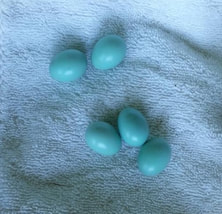 Eastern bluebird eggs held temporarily on a soft towel.
Eastern bluebird eggs held temporarily on a soft towel.
The Great Bluebird Rescue of 2022
By Camille Grabb and Leslie Fellows, with rescue details shared by Pam Narney
John and Pam Narney, VMNs in the Northern Neck Chapter, deserve “Laurels” for their swift and effective handling of a bluebird nesting box crisis this past summer. John has been the coordinator of the Bluebird activity for our chapter for a number of years, and Pam has been a monitor with him. They are also avid Osprey supporters, having an Osprey platform off their property near Colonial Beach and observing, for many years, the osprey parents and young as they come and go. Pam writes a blog about the ospreys throughout their season, presents osprey programs for local groups, and is known locally as “the Osprey Queen.” She has “OSPRY QN” on one license plate and “AVES” on the other. As Pam has says, “I love flyers; that’s why I married a helicopter pilot!” It is also why she helped create the first Osprey Fest in Colonial Beach, now held annually. Their part in what we’re calling “The Great Bluebird Rescue of 2022” shows their deep commitment to, and respect for, all of nature.
One morning in June, two of us started our bluebird monitoring at Westmoreland State Park. When we opened our first box, a mama bluebird flew out. Five eggs were in her nest, and that wasn’t all. We quickly noticed that the box was infested with thousands of ants. They were everywhere, including all throughout the nest strata. There was no question that once the eggs hatched the babies would be killed within minutes, and it would be a painful death. Our initial gut reaction was to remove and destroy the nest, eggs and all. But first we decided to call John Narney, our Chapter Bluebird Coordinator, to see if he could give us any alternative. John and wife Pam called Anne Little, of the Virginia Bluebird Society, to see if she had any suggestions.
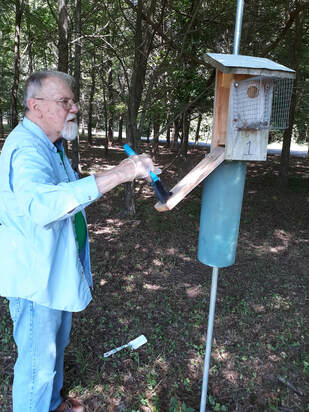 VMN volunteer John Narney cleaning out the bluebird nest box that had been infested with ants.
VMN volunteer John Narney cleaning out the bluebird nest box that had been infested with ants.
She explained that the only likely way to save the babies was to carefully remove the eggs, discard the infested nest, brush all the ants out of the box, then cover the now empty box inside with diatomaceous eart
h, build a new nest, place it in the box, then place the eggs in the new nest. John and Pam went to the park and quickly got to work. The eggs were carefully removed from the nest and placed on a towel. The nest and the ants were removed from the box and the box was thoroughly brushed. Pam crafted a new nest from pine straw!
The following day, diatomaceous earth was sprinkled on the bottom of the box and around the base of the support pole to prevent the ants from returning. Pam placed that nest in the box on top of the diatomaceous earth. The five eggs were gently placed in this new nest inside their box. Almost immediately the parents returned.
Six days later we returned to check the box. Mama was there incubating an ant-free clutch of five eggs, which eventually successfully hatched and added 5 new bluebirds to the Westmoreland population.
And now we ALL realize what to do if we encounter an ant-infested bluebird box!
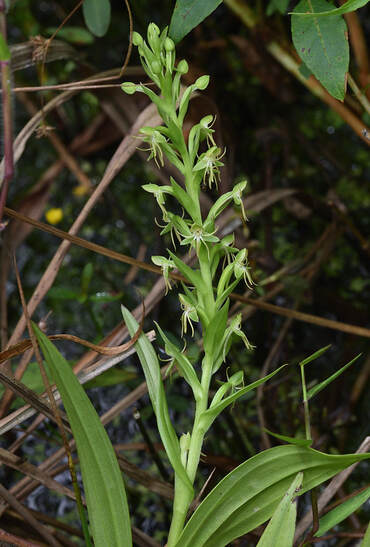 Water-spider orchid (Habenaria repens). Photo by Zach Bradford, DCR. Used with permission.
Water-spider orchid (Habenaria repens). Photo by Zach Bradford, DCR. Used with permission.
Volunteers Spot a Rare Plant
While on a field session at the Great Dismal Swamp National Wildlife Refuge during the Virginia Master Naturalist Statewide Conference, several VMN volunteers spotted an interesting plant. It appeared to be some sort of orchid, and one volunteer uploaded a photo to iNaturalist. DCR Natural Heritage Chesapeake Bay Region Steward Zach Bradford saw the posting on iNaturalist and was able to identify it as the first verified Virginia occurrence of Habenaria repens, water-spider bog orchid. It’s a largely southern species (that ranges into South America) that has seemingly been inching towards that Virginia state line in recent decades, with the previous closest population about 15 miles to the south in NC. Zach then visited the population the following week and reports that it is small but shows clear evidence of reproduction. The occurrence is now listed in the Digital Atlas of the Virginia Flora (with an acknowledgement of the VMN volunteers’ involvement.) Due to the horticultural popularity of the species and the incredible ease in poaching from this very accessible population, the location information is deliberately vague.
Well done, Margaret Chatham (VMN Arlington Regional Chapter), David Gorsline (VMN Fairfax Chapter), and other VMN volunteers involved in this discovery!
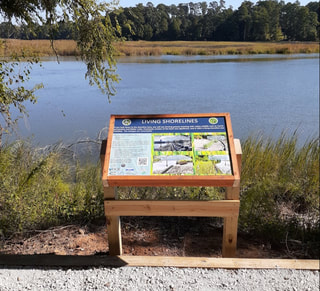 The interpretative sigh designed by chapter members installed recently along the banks of Cypress Creek. Photo by Henry McBurney.
The interpretative sigh designed by chapter members installed recently along the banks of Cypress Creek. Photo by Henry McBurney.
Historic Southside Finishes a Living Shoreline Demonstration
The Historic Southside Chapter finally put the finishing touches on a project chapter volunteers began helping with about twenty-one months ago.
In the early spring of 2021, a VIMS designed living shoreline was slated to be installed along an eroded section of Cypress Creek within Windsor Castle Park in Smithfield, VA.
Numerous volunteers from the Historic Southside Chapter put many hours helping with all phases of this project. For a history of the many hours volunteers contributed to this important project, visit the Nature in Windsor Castle Park site.
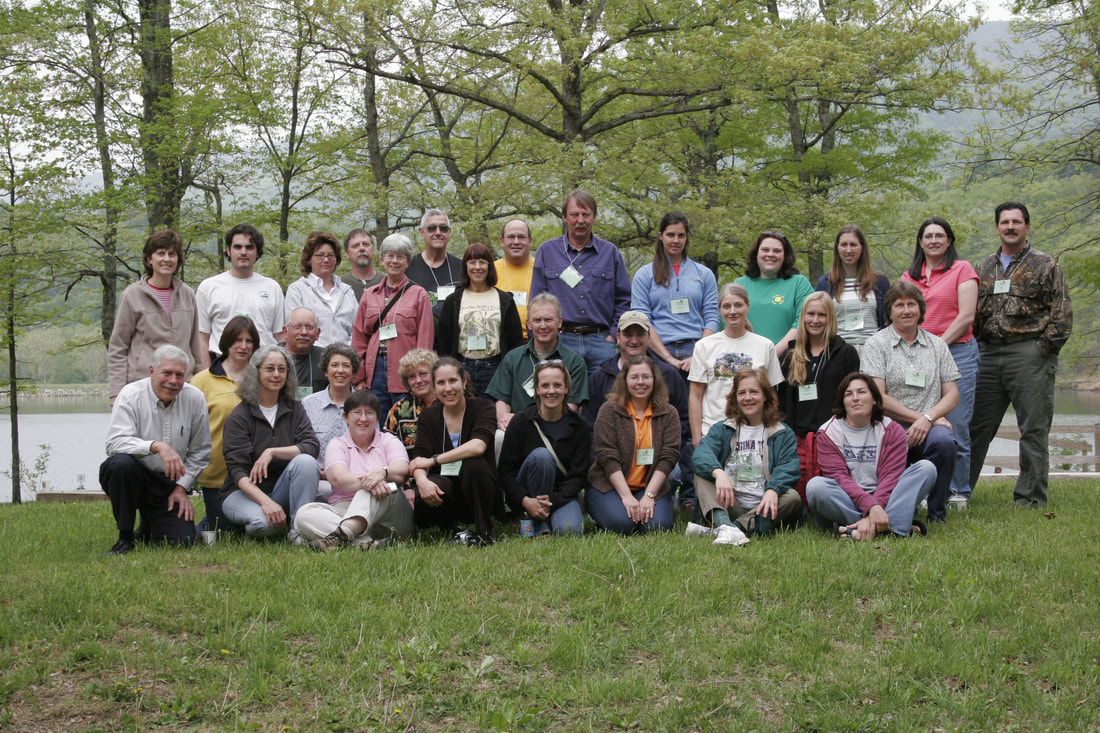 Participants in the first VMN New Chapter Coordinators Training at Douthat State Park in May 2006.
Participants in the first VMN New Chapter Coordinators Training at Douthat State Park in May 2006. 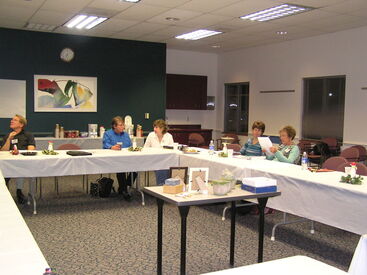 First Riverine Annual Meeting, Hanover DSS Room, December 2007.
First Riverine Annual Meeting, Hanover DSS Room, December 2007. 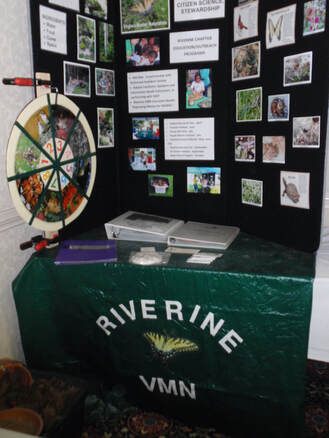 Riverine booth promoting “Habitat at Home” project with spinning wheel on left.
Riverine booth promoting “Habitat at Home” project with spinning wheel on left. 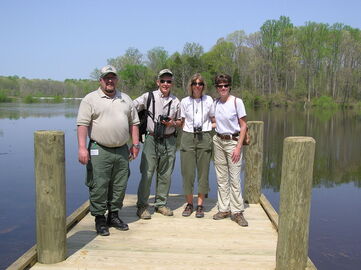 DWR Wildlife Refuge in Powhatan. Riverine members worked on building a trail along the lake in 2009.
DWR Wildlife Refuge in Powhatan. Riverine members worked on building a trail along the lake in 2009. 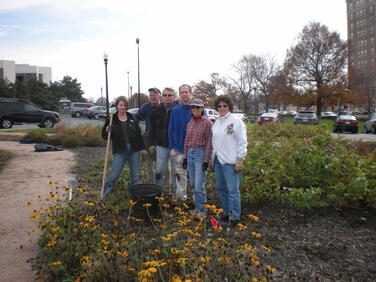 Planting the Bayscape Garden at the Science Museum of Virginia. 2009.
Planting the Bayscape Garden at the Science Museum of Virginia. 2009.

